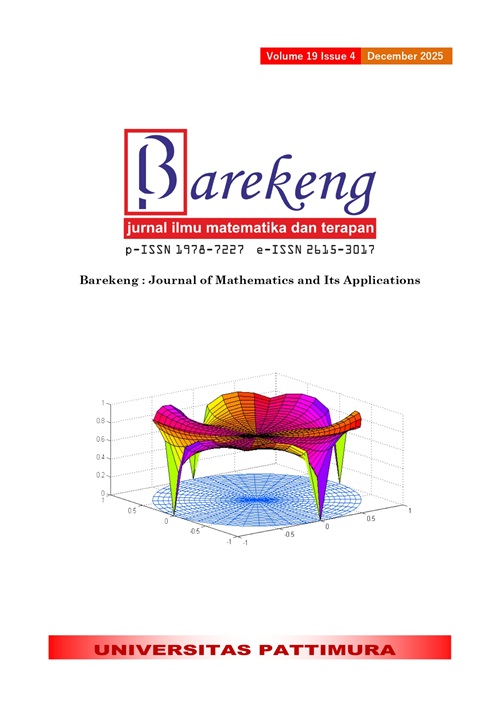THE LINEARITY OF THE EXPECTED VALUE OF A FUZZY VARIABLE
Abstract
In this research, we introduce a novel credibility measure defined as a non-empty set satisfying the axioms of normality, monotonicity, self-duality, and maximality. Based on this credibility measure, a credibility space is constructed, upon which a fuzzy variable can be defined. Similar to fuzzy numbers, fuzzy variables are characterized by membership functions. The membership function of this fuzzy variable is directly derived from the credibility measure. Subsequently, by integrating the credibility measure, the expected value of the fuzzy variable is obtained. The linearity property of fuzzy expected value on fuzzy variables will be proven. This linearity property is highly useful in solving various problems involving fuzzy variables. Therefore, the proposed credibility measure provides a new framework in fuzzy variable theory. This credibility measure not only offers a more formal approach to measuring uncertainty but also opens up possibilities for the development of more complex and applicable fuzzy models.
Downloads
References
L. A. Zadeh, “FUZZY SETS,” Inf. Control, vol. 8, pp. 338–353, 1965, doi: https://doi.org/10.1016/S0019-9958(65)90241-X
L. A. Zadeh, C. S. Division, and C. Sciences, “POSSIBILITY THEORY VS PROBABILITY THEORY IN DECISION ANALYSIS,” IEEE Xplore, vol. 94720, no. 4, pp. 4–6, 1978.
S. Nahmias, “FUZZY VARIABLES,” Fuzzy Sets Syst., vol. 1, pp. 97–110, 1978.doi: https://doi.org/10.1016/0165-0114(78)90011-8
H. J. Zimmermann, FUZZY SET THEORY AND ITS APPLICATIONS, SECOND, REVISED EDITION. New York: Springer Science Business Media New York, 1991.
B. Liu and K. Iwamura, “CHANCE CONSTRAINED PROGRAMMING WITH FUZZY PARAMETERS,” Fuzzy Sets Syst., vol. 94, pp. 227–237, 1998.doi: https://doi.org/10.1016/S0165-0114(96)00236-9
P. F. Halsey Royden, REAL ANALYSIS (4TH EDITION). China: Pearson Education Asia Limited and China Machine Press, 2010.
X. Li and B. Liu, “A SUFFICIENT AND NECESSARY CONDITION FOR CREDIBILITY MEASURES,” Int. J. Uncertain., vol. 14, no. 5, pp. 527–535, 2006.doi: https://doi.org/10.1142/S0218488506004175
B. Liu, THEORY AND PRACTICE OF UNCERTAIN PROGRAMMING, Second Edi. Moscow: Springer-Verlag Company, 2008.
B. Liu, “A SURVEY OF CREDIBILITY THEORY,” Fuzzy Optim. Decis. Mak., vol. 5, no. 4, pp. 387–408, 2006, doi: https://doi.org/10.1007/s10700-006-0016-x.
X. Li and B. Liu, “NEW INDEPENDENCE DEFINITION OF FUZZY RANDOM VARIABLE AND RANDOM FUZZY VARIABLE,” World J. Model. Simul., vol. 2, no. 5, pp. 338-342 New, 2006.
B. Liu, S. Member, and Y. Liu, “EXPECTED VALUE OF FUZZY VARIABLE AND FUZZY EXPECTED VALUE MODELS,” IEEE Trans. Fuzzy Syst., vol. 10, no. 4, pp. 445–450, 2002.doi: https://doi.org/10.1109/TFUZZ.2002.800692
B. Liu, UNCERTAINTY THEORY, Second Edi. Springer, 2005.
F. Xue, W. Tang, and R. Zhao, “THE EXPECTED VALUE OF A FUNCTION OF A FUZZY VARIABLE WITH A CONTINUOUS MEMBERSHIP FUNCTION,” Comput. Math. with Appl., vol. 55, pp. 1215–1224, 2008.doi: https://doi.org/10.1016/j.camwa.2007.04.042
B. Liu, UNCERTAINTY THEORY (THIRD EDITION). New York: Springer, 2009.
E. Susanti et al., “OPTIMIZATION OF RICE INVENTORY USING FUZZY INVENTORY MODEL AND LAGRANGE INTERPOLATION METHOD,” BAREKENG J. Ilmu Mat. and Terap., vol. 17, no. 3, pp. 1215–1220, 2023, doi: 1 https://doi.org/10.30598/barekengvol17iss3pp1215-1220.
E. F. Ma’rif and A. M. Abadi, “FUZZY APPLICATION (MAMANDI METHOD) IN DECISION-MAKING ON LED TV SELECTION,” BAREKENG J. Ilmu Mat. and Terap., vol. 18, no. 2, pp. 1117–1128, 2024, doi: https://doi.org/10.30598/barekengvol18iss2pp1117-1128
Indarsih, “A SINGLE ITEM PRODUCTION INVENTORY MODEL WITH THE FUZZY DEMAND,” IAENG Int. J. Appl. Math., vol. 54, no. 8, pp. 1673–1677, 2024.
G. Beliakov, “KNAPSACK PROBLEMS WITH DEPENDENCIES THROUGH NON-ADDITIVE MEASURES AND CHOQUET INTEGRAL,” Eur. J. Oper. Res., vol. 301, no. 1, pp. 277–286, 2022.doi: https://doi.org/10.1016/j.ejor.2021.11.004
H. Doukas and A. Nikas, “DECISION SUPPORT MODELS IN CLIMATE POLICY,” Eur. J. Oper. Res., vol. 280, no. 1, pp. 1–24, 2020.doi: https://doi.org/10.1016/j.ejor.2019.01.017
S. Y. Chi and L. H. Chien, “WHY DEFUZZIFICATION MATTERS: AN EMPIRICAL STUDY OF FRESH FRUIT SUPPLY CHAIN MANAGEMENT,” Eur. J. Oper. Res., vol. 311, no. 2, pp. 648–659, 2023.doi: https://doi.org/10.1016/j.ejor.2023.05.037
X. Li and D. A. Ralescu, “CREDIBILITY MEASURE OF FUZZY SETS AND APPLICATIONS,” Int. J. Adv. Intell. Paradig., vol. 1, pp. 241–250, 2009.doi: https://doi.org/10.1504/IJAIP.2009.026567
Copyright (c) 2025 Uvi Dwian Kencono, Indarsih - Indarsih

This work is licensed under a Creative Commons Attribution-ShareAlike 4.0 International License.
Authors who publish with this Journal agree to the following terms:
- Author retain copyright and grant the journal right of first publication with the work simultaneously licensed under a creative commons attribution license that allow others to share the work within an acknowledgement of the work’s authorship and initial publication of this journal.
- Authors are able to enter into separate, additional contractual arrangement for the non-exclusive distribution of the journal’s published version of the work (e.g. acknowledgement of its initial publication in this journal).
- Authors are permitted and encouraged to post their work online (e.g. in institutional repositories or on their websites) prior to and during the submission process, as it can lead to productive exchanges, as well as earlier and greater citation of published works.






1.gif)



